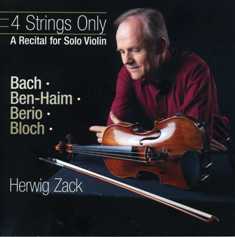
4 Strings and 4 B's = Rewarding Listening 4 U

|
If you like a violin, this album for solo violin, the second by violinist Herwig Zack for Avie Records, gets an A. Several A’s, in fact, for A or G is the key or central note of each work heard here. As explained in Zack’s helpful liner notes, each piece references or contrasts with one or more of the others (all may be said to look back to Bach, ultimately), and Ben-Haim’s Sonata in G shares a similar construction principle with Berio’s Sequenza VIII (elaboration around central notes).
The centrality of Bach is emphasized by its placement, between the two Bloch Suites, which date from the composer’s later, more neo-classical period. It is performed with less regard for baroque practice, giving it an even closer kinship to the 20th-century composer. It is a noble reading, even touched with romance. Particularly lovely is the Andante, where the violin accompanies itself in double stops. The Bloch Suites, written in 1958 for Yehudi Menuhin, compel attention, with full regard to their emotive differences: bright and assertive in No. 2, more reserved in No. 1. There is a gulf between the “Jewishness” of these works and Bloch’s earlier output. So, too, do they differ from Israeli composer Ben-Haim’s Sonata in G.
The
conjunction of Ben-Haim’s Sonata and Berio’s Sequenza VIII provides some of the most rewarding listening
on this generous (77-minute) disc. Born
in Germany as Paul Frankenburger, Ben-Haim left in 1933 and settled in Palestine,
where he set about redefining Jewish music, in large part from Middle Eastern
sources. His Sonata in G (1951), also composed for Menuhin,
creates a mood from the outset of the Allegro
energico, with its assertive opening statement and repeated ornamental
motif. The second movement, Lento e sotto voce, performed muted, has
a gently perfumed air, climbing high into the violin’s upper register, while
the whirlwind finale is joyful and dance-like.
Berio wrote 14 Sequenze for solo instruments and voice. His 1976 Sequenza VIII for solo violin (written for violinist Carlo Chiarappa) unfolds around two persistent notes, A and B, often becoming quite virtuosic. The alternation of rapid moto perpetuo passages with chordal outbursts creates a startling effect at one point. The sound in the Kammermusiksaal der Hochschule für Musik in Würzburg is well-nigh perfect, giving a closely defined, but glossy edge to Zack’s tone.